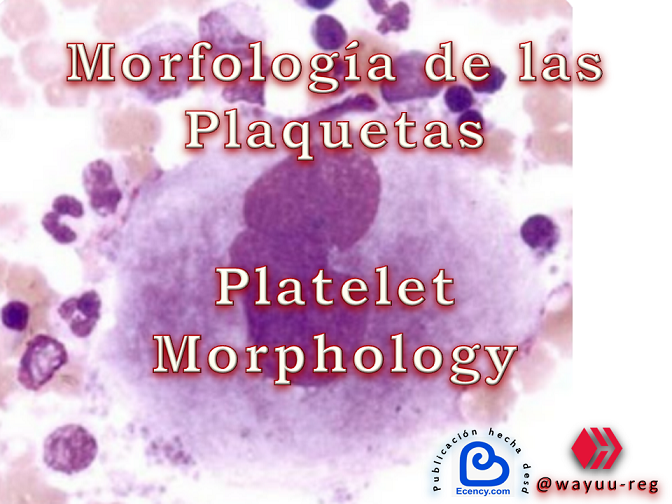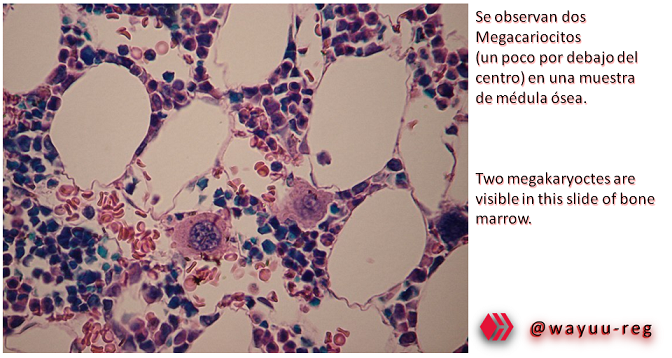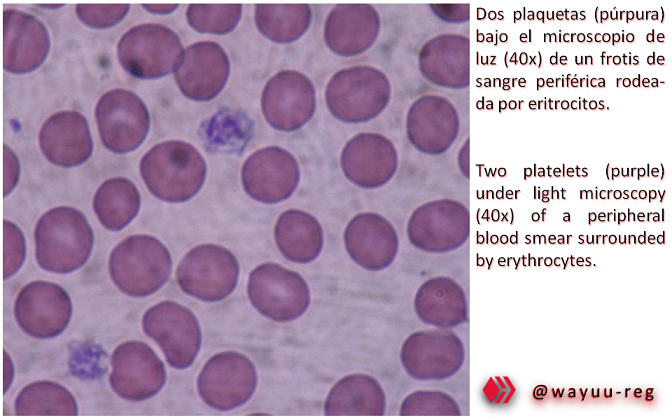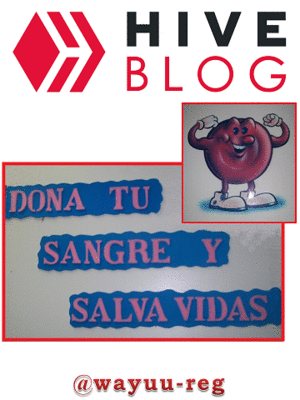Antes de adentrarnos a la investigación científica de las funciones químicas y físicas, además de los mecanismos de cualquier organismo vivo (como la sangre, por ejemplo); es necesario exponer la estructura de las plaquetas, con la explicación de sus componentes, según aspectos físicos de la forma externa, también la descripción de la estructura interna. En donde, se hace referencia de las zonas periférica, sol-gel y organelos, del sistema vivo plaquetario.
Before entering into the scientific investigation of the chemical and physical functions, as well as the mechanisms of any living organism (such as blood, for example); it is necessary to expose the structure of platelets, with the explanation of its components, according to physical aspects of the external form, as well as the description of the internal structure. Here, reference is made to the peripheral, sol-gel and organelle zones of the platelet living system.

Megakaryocyte size 20-90 µm Nucleus 2-16 lobules, with presence of blue to reddish granules. Cytoplasm slightly basophilic N:C ratio variable. Reference ranges: Peripheral blood 0% Description: derived by the action of thrombopoietin to grow and replicate their DNA without reaching cytokinesis. Posted on Pinterest by Anacris Caballeros
Las plaquetas son pequeños corpúsculos sanguíneos, provenientes de la fragmentación citoplasmática del megacariocito, que es su célula madre. Las plaquetas se producen principalmente en la médula ósea, bajo estímulos no bien definidos, aunque hay base para pensar que una sustancia humoral (trombopoyectina) regularía la trombopoyesis, de una manera similar a como la eritropoyetina lo hace con los eritrocitos.
Platelets are small blood corpuscles, derived from the cytoplasmic fragmentation of the megakaryocyte, which is their parent cell. Platelets are produced mainly in the bone marrow, under not well defined stimuli, although there is a basis for thinking that a humoral substance (thrombopoietin) would regulate thrombopoiesis, in a similar way as erythropoietin does with erythrocytes.

Two megakaryoctes are visible in this slide of bone marrow
Se ha demostrado que cultivos de células renales embrionarias son capaces de producir una sustancia que estimula la trombopoyesis. Las plaquetas recién liberadas a la circulación son más grandes del tamaño usual.
It has been shown that embryonic kidney cell cultures are capable of producing a substance that stimulates thrombopoiesis. The platelets newly released into circulation are larger than the usual size.
La duración de las plaquetas en la circulación es de 8 a 11 días. El número normal de las plaquetas de la sangre periférica es de 200 a 400.000 mm3, es decir, 200 a 400 x 109/1. Aproximadamente la tercera parte de las plaquetas circulantes está en el “pool” esplénico.
The duration of platelets in circulation is 8 to 11 days. The normal number of platelets in the peripheral blood is 200 to 400,000 mm3, i.e. 200 to 400 x 109/1. Approximately one third of the circulating platelets are in the splenic pool.
En las plaquetas, se distinguen tres zonas: periférica, sol-gel y organelos
In platelets, three zones are distinguished: peripheral, sol-gel and organelles
In platelets, three zones are distinguished: peripheral, sol-gel and organelles
Plaquetas zona periférica
Es la pared celular, se compone, a su vez, de una capa exterior rica en mucopolisacáridos y licoproteínas, con tendencia a unirse con proteínas y cationes, y que se continúa con sistema de canlículos en el interior plaquetario, conocido como sistema canicular abierto (CS), una membrana trilaminar rica en lipoproteínas indistinguibles morfológicamente de otras membranas celulares, y que ha sido implicada en la disponibilidad del factor plaquetario 3 durante la agregación, y un área de sub-membrana que contiene un sistema regular de elementos filamentosos, cuya función parece ser el cooperar con el sistema de microtúbulos circunferenciales en mantener la forma discoidea plaquetaria, ayudar la formación de psudópodos y mediante interacciones con otros elementos contráctiles de la plaqueta, ayudar a la retracción de coágulo y a la liberación de los componentes funcionales plaquetarios.
Peripheral zone platelets
It is the cell wall, is composed, in turn, of an outer layer rich in mucopolysaccharides and lycoproteins, with a tendency to bind with proteins and cations, and which is continued with canicule system in the platelet interior, known as open canicular system (CS), a trilamellar membrane rich in lipoproteins morphologically indistinguishable from other cell membranes, and which has been implicated in the availability of platelet factor 3 during aggregation, and a sub-membrane area containing a regular system of filamentous elements, whose function appears to be to cooperate with the circumferential microtubule system in maintaining platelet discoid shape, assisting psudopod formation and through interactions with other contractile elements of the platelet, assisting clot retraction and the release of functional platelet components.
Las glicoproteínas de esta capa tienen gran importancia en la fisiología plaquetaria. Al menos 15 diferentes glicoproteínas han sido identificadas. La glicoproteína I (GP-I) tiene varios componentes, uno de los cuales, la I-a, es llamada glicocalicina y está implicada en la interacción de las plaquetas con la trombina y con superficies subendoteliales. Esta glioproteína es similar a la GP-Ib, y ambas están disminuidas en la enfermedad de Bernard-Soulier.
The glycoproteins of this layer are of great importance in platelet physiology. At least 15 different glycoproteins have been identified. Glycoprotein I (GP-I) has several components, one of which, I-a, is called glycocalicin and is involved in the interaction of platelets with thrombin and with subendothelial surfaces. This glycoprotein is similar to GP-Ib, and both are decreased in Bernard-Soulier disease.
Las glicoproteínas IIb y IIIa están reducidas en otra trombopatía, la tromboastenia de Glanzman. La glicoproteína IIIa también se conoce como alfa-actinina y parece estar en relación con el anclaje del mecanismo contráctil de la plaqueta.
Glycoproteins IIb and IIIa are reduced in another thrombopathy, Glanzman's thromboasthenia. Glycoprotein IIIa is also known as alpha-actinin and appears to be related to the anchoring of the platelet contractile mechanism.
Plaquetas zona sol-gel
Dos sistemas adicionales de fibras se encuentran en esta zona. El más prominente es el sistema de microtúmulos circunferenciales, o sea una banda de estructuras tubulares que rodean la circunferencia de la plaqueta, al parecer formados por estructuras subfilamentosas helicoidales. Parecen ser el cito esqueleto plaquetario y sufren desplazamiento central y reducción de su circunferencia durante la agregación plaquetaria, orientando la onda de contracción que resulta en la extrusión de los productos endógenos plaquetarios.
Sun-gel zone
.Two additional fiber systems are found in this zone. The most prominent is the circumferential microtubule system, that is, a band of tubular structures surrounding the circumference of the platelet, apparently formed by helical subfilamentous structures. They appear to be the platelet cytoskeleton and undergo central displacement and reduction of their circumference during platelet aggregation, orienting the contraction wave that results in the extrusion of platelet endogenous products.
El tercer sistema de fibras plaquetarias y el segundo de la zona de sol-gel (el tercero es el sistema filamentoso del área sub-membrana de la zona periférica) es el sistema de micofilamentos, de aproximadamente 50 A de diámetro y muy parecidos a los de actina vistos en el músculo. Parece por lo tanto que forman parte de la molécula de trombostenina, la proteína contráctil de la plaqueta.
The third platelet fiber system and the second of the sol-gel zone (the third is the filamentous system of the sub-membrane area of the peripheral zone) is the myofilament system, approximately 50 A in diameter and very similar to those of actin seen in muscle. They therefore appear to be part of the thrombostenin molecule, the contractile protein of the platelet.
Plaquetas zona de organelos
Diversos organelos, como gránulos (G), ricos en fosfolípidos y sitios de almacenamiento de diversas sustancias contráctiles, o vaso-activas, además de un “pool” no metabólico de ADP y ATP, cuerpos densos (DB), ricos en serotonina, y mitocondrias, que contribuyen al metabolismo energético de la célula, se encuentran en esta parte plaquetaria.
Plaquettes organelle zone
.Various organelles, such as granules (G), rich in phospholipids and storage sites for various contractile, or vaso-active, substances, in addition to a non-metabolic "pool" of ADP and ATP, dense bodies (DB), rich in serotonin, and mitochondria, which contribute to the cell's energy metabolism, are found in this platelet part.
Existen además en las plaquetas sistemas de membrana, como el sistema canalicular abierto (citado en la zona periférica), el cual comprende, además del aparato de Golgi (GZ), de actividad funcional desconocida en las plaquetas, y el sistema tubular denso (DTS), asociado de la banda circunferencial de microtúbulos, y a quien se supone estar involucrado en la elaboración de filamentos para los sistemas fibrosos plaquetarios y servir como molde para la organización de los microtúbulos circunferenciales.
There are also membrane systems in platelets, such as the open canalicular system (mentioned in the peripheral zone), which comprises, in addition to the Golgi apparatus (GZ), of unknown functional activity in platelets, and the dense tubular system (DTS), associated with the circumferential microtubule band, and which is supposed to be involved in the elaboration of filaments for platelet fibrous systems and to serve as a mold for the organization of circumferential microtubules.

¡ Muchísimas gracias
por su amable atención !
por su amable atención !
Y recuerde que donar sangre,
es salvar muchas vidas…
es salvar muchas vidas…
Thank you very much
for your kind attention !
for your kind attention !
And remember that to donate blood,
is to save many lives...
is to save many lives...

FUENTES BIBLIOGRÁFICAS (Bibliographic Sources)
⊛ Trastornos de la función plaquetaria
Platelet function disorders
⊛ Aspectos Estructurales y Funcionales de las Plaquetas
Structural and Functional Aspects of Platelets
⊛ Plaquetas: valores normales y qué causan que estén altas o bajas
Platelets: normal values and what causes them to be high or low
⊛ Plaquetas (Platelet)
Todas las imágenes de esta publicación son de dominio público (CC0), fueron editadas con la aplicación Paint y PowerPoint como imagen PNG
La imagen GIF, con fotografías personales, fue editada con la aplicación en línea Picasion.com
Se utilizó el Logo de Hive.blog (CC0) y Ecency Logo
La traducción fue realizada por DeepL
Me sentiría muy complacida en recibir su valioso comentario y constructivas sugerencias acerca del tema presentado, ya que serán considerables para el mejoramiento de las futuras publicaciones
¡ G R A C I A S !
All images in this publication are in the public domain (CC0) and were edited with Paint and PowerPoint as PNG images
The GIF image, with personal photos, was edited with the online application Picasion.com
The Hive.blog Logo (CC0) and Ecency Logo was used
The translation was made by DeepL
I would be very pleased to receive your valuable comments and constructive suggestions on the topic presented, as they will be considerable for the improvement of future publications
T H A N K Y O U !

Thanks for the scientific lesson 😊. !PIZZA
I gifted $PIZZA slices here:
(12/20) @blitzzzz tipped @wayuu-reg (x1)
Send $PIZZA tips in Discord via tip.cc!
!LUV
(1/1) gave you LUV. tools | wallet | discord | community | <>< daily
tools | wallet | discord | community | <>< daily
HiveBuzz.me NFT for Peace
Su post ha sido valorado por @ramonycajal
Congratulations @wayuu-reg! You have completed the following achievement on the Hive blockchain and have been rewarded with new badge(s):
Your next target is to reach 8000 upvotes.
You can view your badges on your board and compare yourself to others in the Ranking
If you no longer want to receive notifications, reply to this comment with the word
STOPCheck out the last post from @hivebuzz:
Congratulations @wayuu-reg! You received a personal badge!
You can view your badges on your board and compare yourself to others in the Ranking
Check out the last post from @hivebuzz: